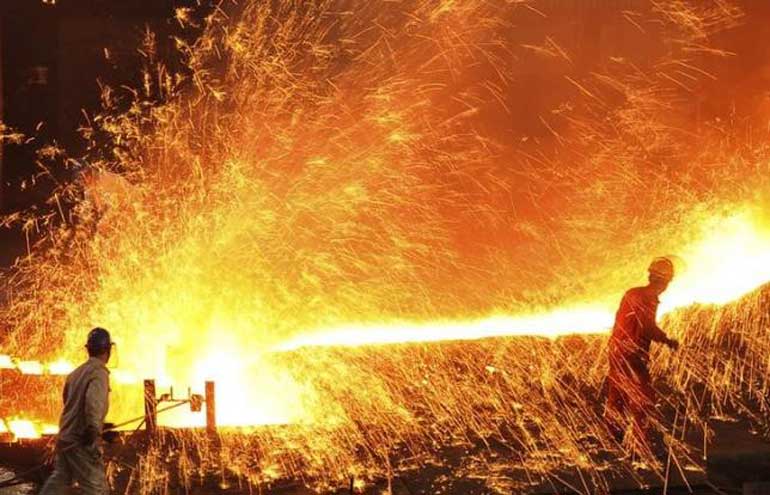Saturday Mar 15, 2025
Saturday Mar 15, 2025
Saturday, 22 August 2015 00:00 - - {{hitsCtrl.values.hits}}
 Employees work at a steel factory in Dalian, Liaoning province -REUTERS
Employees work at a steel factory in Dalian, Liaoning province -REUTERS
Stock markets tumbled on Friday after a survey showed Chinese factories contracted at their fastest pace since the depth of the global financial crisis in 2009, sending investors scurrying to the safety of bonds and gold.
Emerging market assets took a hammering, and oil prices were on track for their longest losing streak since 1986, as fears of a China-led deceleration in global growth gripped markets. MSCI’s broadest index of Asia-Pacific shares outside Japan fell 2.4% to its lowest since July 27, 2012, for a weekly loss of 6.1%.
Shanghai stocks dropped 4% to below the 200-day moving average for the first time since July 2014. That brought losses for the week to 11%. The Hang Seng index in Hong Kong was down 2.4% for a weekly loss of 7.4%.
Markets in countries whose economic fortunes were closely linked to China’s growth tumbled. Japan’s Nikkei declined 2.9%, for a weekly loss of 5.2%. South Korea’s Kospi shed 1.6%, and was 4% lower for the week.
European markets are set to follow suit, with financial spreadbetter IG expecting Britain’s FTSE 100 to open 144 points lower, or down 2.2%, Germany’s DAX .GDAXI to open 325 points lower, or down 3.1%, and France’s CAC 40 .FCHI to open 121 points lower, or down 2.5%.
The S&P 500 and the Dow Jones index slumped below their 200 day averages overnight.
The mood in markets, already soured by the weakness on Wall Street, darkened further on the grim reading of China’s factory activity.
The Caixin/Markit manufacturing index showed activity in China’s factory sector shrank at its fastest pace in almost 6 1/2 years in August as domestic and export demand dwindled. That decline, coming on the heels of weaker-than-expected data in July, stoked fears of a slowdown in the world’s second-biggest economy.
“Markets are pricing in the worst right now,” said Herald Van Der Linde, head of Asian equity strategy at HSBC.
The MSCI emerging markets index slid 1.7% to the lowest since 19 August 2009.
US stock futures fell almost 0.5% to a six-month low in Asian trade after the Chinese PMI was released.
The Australian dollar AUD=D4, considered a liquid proxy for China demand, slid to $ 0.7285 at one point and was last trading at $ 0.7304, down 0.5% for the day. The market ructions sent gold XAU=up to its highest level in more than a month.
Safe-haven US Treasury yields also slipped further. They were already feeling a downward pull after minutes from the Federal Reserve’s July meeting offered little clue of a near-term rate hike, denting expectations of a tightening in September.
“The US markets have held up well of late, being viewed as somewhat of a safe-haven,” wrote Chris Weston, chief market strategist at IG in Melbourne.
“This view seems to have deteriorated somewhat with the S&P 500 closing below its multi-month trading range – a fate the credit markets and the US yield curve have been screaming for some time.”
Lower Treasury yields in turn weighed on the dollar. The currency traded at 122.82 yen JPY=, the lowest in more than five weeks, after sinking from an overnight high of 124.16.
The euro hovered near a two-month high at $ 1.1290 EUR= after surging 1.1% on Thursday.
In commodities, crude oil resumed its downward trend. US crude CLc1 was headed for its eight straight weekly decline, slipping 0.5% to $ 40.85 after touching a multi-year low of $ 40.21 on Thursday.
Discover Kapruka, the leading online shopping platform in Sri Lanka, where you can conveniently send Gifts and Flowers to your loved ones for any event including Valentine ’s Day. Explore a wide range of popular Shopping Categories on Kapruka, including Toys, Groceries, Electronics, Birthday Cakes, Fruits, Chocolates, Flower Bouquets, Clothing, Watches, Lingerie, Gift Sets and Jewellery. Also if you’re interested in selling with Kapruka, Partner Central by Kapruka is the best solution to start with. Moreover, through Kapruka Global Shop, you can also enjoy the convenience of purchasing products from renowned platforms like Amazon and eBay and have them delivered to Sri Lanka.
Discover Kapruka, the leading online shopping platform in Sri Lanka, where you can conveniently send Gifts and Flowers to your loved ones for any event including Valentine ’s Day. Explore a wide range of popular Shopping Categories on Kapruka, including Toys, Groceries, Electronics, Birthday Cakes, Fruits, Chocolates, Flower Bouquets, Clothing, Watches, Lingerie, Gift Sets and Jewellery. Also if you’re interested in selling with Kapruka, Partner Central by Kapruka is the best solution to start with. Moreover, through Kapruka Global Shop, you can also enjoy the convenience of purchasing products from renowned platforms like Amazon and eBay and have them delivered to Sri Lanka.